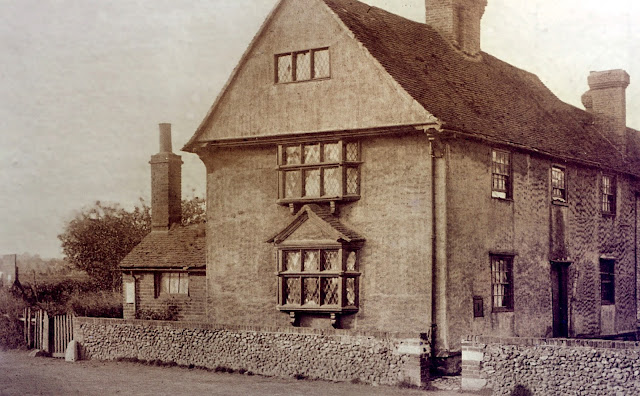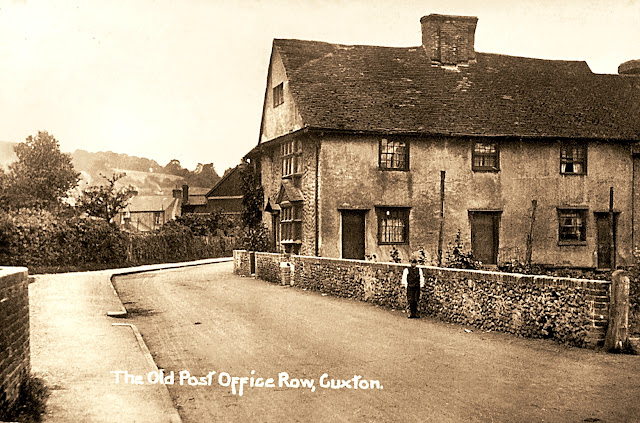 |
| Old Post Office Row in 1959, and how the area appears now... |
Opposite the entrance to the Cuxton Scout hall in Bush Road once stood Old Post Office Row. I’m not quite sure when it was built, although it is thought to date back to the 17th century. It does not appear on the (rather crude and inaccurate) Andrews, Jury and Herbert map of the Cuxton area in 1769, but is clearly shown on the (unpublished – held in the British Museum) OS map of 1789.
 |
| Map of Cuxton, 1769... |
 |
| Map of Cuxton, 1789, with Post Office Row arrowed... |
As its name suggests, the Row was home to Cuxton’s post office until the local postal service relocated, (sometime in the 1890s) to the cottage on Bush Road that is now No. 35.
 |
| No. 35 Bush Road, c. 1900 and 1971. |
Built in around 1840, long before the houses either side of it, 35 Bush Road was home to Cuxton's Post Office until around 1900. The lady in the picture above may possibly be Flora Chalklen, wife of Daniel Chalklen, whom Kelly's Directory lists as "grocer and draper at the post office" in 1900.
The Post Office business then subsequently moved a couple of doors down to the shop (no. 39) on the corner of Bush Road (then known as Cuxton Street) and May Street (then known as Jupp Street), which was built around then.
 |
| Percy Chalklen and his fiance, Elsie Camber, outside of the "new" Bush Road Post Office, c.1913... |
Percy Chalklen (above) was the son of postmaster Daniel Chalken, and acted as the telegram boy. Daniel's other son, David, was the postman.
 |
| Old Post Office Row, c.1900. The post box can be seen, set in the wall on the right... |
 |
| c.1910. Note the additional side doors, suggesting that the building had been subdivided. |
 |
| The PO row buildings, c.1950. Note the extension and loss of the loft window... |
Although they had fallen somewhat into disrepair by the 1960s, a 1962 report by the SPAB (Society for the Protection of Ancient Buildings) stated that “all were worthy of preservation”.
Needless to say, that was way too much like hard work for the local municipal council and so the Old Post Office Row was demolished in 1963. The existing bungalows were built some years later (late seventies I think).
 |
| Same view as the 1910 one above, 1973. Note how much wider Bush Road is...! |
The Post Office itself stayed at 39 Bush Road (with Mrs. E, Swaisland as postmistress) until it moved, in around 1969, over to the row of shops that were built opposite the end of Wood Street in the early 1960s. Curiously the then-postmaster, Mr. Bovis, got to occupy a corner of Fry's butcher's shop, which seemed an odd mix of businesses. The post office counter remained in the butcher's shop (latterly run by G.M. Robinson) right up until around 2012, until the butchers finally closed and the Post Office had the shop to itself.
 |
| Bush Road shops, 1970. The post office was then at No. 68, sharing with Fry's the butchers (last shop on the left)... |
In December 2014 it was subjected to an armed robbery, with a terrified shop worker tied up and threatened with a gun. The culprits were never caught. After a few months it reopened, but the lovely folk who ran it rather lost heart (not surprisingly). It soldiered on as a rather bleak, fortified counter until it finally closed for good in December 2019, with the Post Office business moving next door to No. 66 to become part of what is now the "Best One" store. The former butchers/post office has stood forlorn and empty since then.
 |
| Floral display outside the empty Post Office, August 2021... |
Reference:
1) Cuxton: A Kentish Village by Derek Church (published by Arthur J Cassell Ltd, 1976, ISBN 0 903253 12 7), Chapter 6, p 76.
No comments:
Post a Comment